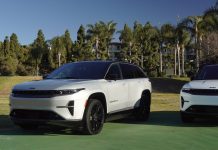Counting our blessings after a crash course in vehicle safety.

178WITHMercedes-Benz provided flights from New York to Stuttgart, Germany, and a night in a hotel so Alex could visit the Mercedes test facility on the way to a drive event (for a different publication). Ars does not accept paid editorial content.
Something unexpected happened as I looked down to watch two Mercedes-Benz EVs crash into each other: I felt… scared.
It was the culmination of a day spent with Mercedes-Benz discussing the company’s plans to fully prevent serious injuries in its vehicles and the first time an automaker publicly conducted a crash test between two EVs, in this case with a select group of journalists in attendance. Witnessing two cars smash into each other would be, at the very least, very exciting.
But I didn’t expect to feel my stomach drop in the moment of impact and the dread that lingered after. The experience hammered home the importance of all the safety measures automakers implement in the cars we spend our lives with and how much work goes into engineering the successful outcomes we hope we never have to experience firsthand.
Crash course
I was among a handful of journalists Mercedes-Benz brought to its Technology Center for Vehicle Safety in Sindelfingen, Germany, a substantial testing facility where the automaker conducts its crash tests throughout the year. The goal was to demonstrate that a collision involving such vehicles is no worse than what we see with gas-powered vehicles. This kind of test goes beyond the standards used by organizations who rate vehicle safety, company spokespeople were keen to point out.
Before the test, we had multiple sessions with specialists from the tech center who walked us through different aspects of Mercedes-Benz’s approach to vehicle safety while reiterating its “Mission Zero” goal to eliminate car crashes in its vehicles by the year 2050.Advertisement

Yes, completely. Paul Dick, director of vehicle safety at Mercedes-Benz, claimed there are currently 1.3 million annual road fatalities worldwide. He equates this to 12 large commercial planes full of people crashing every day for a year, a figure he finds unacceptable. Dick hopes that with the ambitious 2050 target in its sights, Mercedes-Benz can significantly reduce in-car fatalities per every milestone on the way.
Safety dance
The way forward is to prevent incidents before they happen, and to be fully prepared if/when they do. A major factor in this vision is autonomous vehicle functions, as discussed around the cars from the Mercedes-Benz ESF (Experimental Safety Vehicles or Experimentelles Sicherheitsfahrzeug) program, which houses many of the prototypical versions of the automaker’s safety innovations. ESF 2019, in particular, showcased many possible solutions for autonomous road safety, such as implementing ways to communicate with other drivers and passengers of what the vehicle may be doing while in self-driving mode, using LED screens on the rear windshield to display messages to following cars, and even indicating that its occupant is literally sleeping behind the wheel.
Specialists then walked us through the brand’s four stages of its approach to crash safety.
Stage one is assistance, provided by functions like emergency braking and blind-spot monitoring. Stage two is preparation for when the car’s “safety brain” senses an imminent collision, engaging systems like seat-belt tensioners and prepping the airbags for deployment.
Stage three, airbag deployment, is about protection, and stage four is helping in post-collision situations with automatic hazard lights, calling emergency centers, and—with EVs—automatically shutting down the high-voltage system, allowing responders to safely access the vehicle. Our specialist pointed out that emergency responders procedurally disconnect the battery at the start of a rescue in a gas-powered car and that Mercedes provides a wire for them to cut in its EVs for the same purpose.

Included in all of this was a walkthrough of the materials used in the structure of the vehicle. While high-strength steel is used for the passenger cell, there are other areas built to purposely deform so that this cell is never compromised. This works in tandem with the elements of the body meant to warp and deflect the energy of an impact rather than simply withstand it, often to the detriment of the occupants inside.
Finally, we were given an overview of the different crash test dummies used in the testing. Mercedes-Benz pointed out how the industry standards have long since shifted from the familiar male-shaped dummy and has incorporated dummies that represent women, children, and people with different body types. (However, this is mostly in Europe; in March 2023, the US Government Accountability Office published a report calling on the National Highway Transportation Safety Administration to start using more accurate crash test dummies for US crash tests.)
Mercedes told Ars that even those dummies (called THOR) are close to being phased out by new models with more internal sensors and structures to more accurately simulate the effects of car collisions on the body.
The impact
After a day’s worth of panels and discussions, it was finally time to see all the systems we learned about come together. At either end of the facility was an EQA and EQS SUV, staged to meet at a terminus going 56 km/h or around 35 mph with a 50 percent overlap. Both vehicles would be drawn by a pulley system, with their batteries sustaining some level of charge, while each was occupied by a pair of the dummies described from our earlier presentation in the driver and passenger seats—specifically, three female and one male.
As our group gathered at our elevated position behind safety glass, the anticipation was palpable. The ground crew went through its well-practiced procedure to ensure total safety and data capture while we looked on. When it was time, the facilities’ house lights were switched off, leaving the incredibly bright lighting rig to illuminate the scene, an intensity required for the high-speed cameras capturing images at every angle.Advertisement
A video of the EQA and EQS crash test.
“Cover your ears—this will be loud!” exclaimed one of the specialists. Fixated at the point of contact, I watched as two safety-orange masses came together in a calamity, and my heart suddenly sank.
The aftermath
The ground crew immediately swept in to conduct their safety checks and analysis of what remained of the two EVs. Satisfied that all was safe and data was collected, Mercedes allowed us to begin our long walk to the test floor. Along the way, amid all the “wows-and-cools,” I was silent, trying to reconcile why I wasn’t similarly enthused.
On paper, the test was fairly unspectacular: two cars colliding at what’s usually regarded as a fairly low speed in a completely safe, clinical environment while four faceless dummies go along for the ride. We’ve seen more intense stuff on Mythbusters.
In person, it felt far more intense. When the EQS SUV and EQA met, the sound of metal-on-metal thumping, shattering plastics, and screeching rubber sent ice through my veins. Anyone who has been in or near a car accident will instantly know these tragically familiar noises.
When we arrived at the test floor, the scene was grim, even in this simulated environment. Among the debris, both cars sat on either end of the area, wildly deformed. The mass of the EQS meant it was the winner in this clash, and the EQA was sent sliding several yards further than I was expecting. It seemed evident that the GLA’s trajectory would’ve surely sent it into something and created a secondary incident. Its tire-less front left wheel sat alone even farther away, having broken off by the control arm, the remains sheared like a soda can.

Had this been a real-life collision, the state of the cars would give anyone on the scene pause before checking on the occupants. Though I was spared from that reality, the limp, dangling limbs of the dummies and the pings of the onboard warning systems got the point across. Throughout scrutinizing the scene, I repeatedly thought, “This was ‘just’ 35 mph…”
“This is good, actually”
On a more upbeat note, the Mercedes-Benz experts walked us through how this was an overall positive result. Specifically and to the main point of the test, the high-voltage systems of both cars had automatically disengaged, allowing first responders to safely approach. Our specialist pointed out how the cars deformed predictably, absorbing the impact energy and protecting the passenger safety cell.
And the dummies were seemingly no worse for wear. Visually, the contact marks on their extremities indicated which airbags and parts of the dashboard they struck, but it’s impossible to tell how hard those points were hit. Mercedes claimed the internal sensors showed that all the safety systems deployed appropriately, and these stand-ins didn’t suffer serious-to-fatal impacts. Our guide pointed out how the cars deployed only the needed airbags and not all of them, focusing on the occupants and making their recovery easier. The same goes for the level of deformity of the structure, as all doors could be opened and dummies retrieved.
All shook up
I was left split on what to take away from seeing this crash test. Cynically, I imagined that some would take the result as proof that they need to drive hulking utility vehicles to make sure they’re in the biggest car if such an incident ever happened to them. I could also see people pointing to the energy-deflecting structure deformity as an indicator of poor quality, missing the point entirely.Advertisement

As for the EV element, it was something of a relief to see that the electrification of the vehicles didn’t seem to make a difference in the safety of the accident. But even though the high-voltage system automatically disconnected, I’m sure Mercedes-Benz will forgive me if I’m hesitant to approach a wrecked EV.
Ultimately, I was glad to see the results of ongoing safety development for myself—and in a way, I could mostly stomach. Accidents happen, and people in cars still get hurt and die, but vehicles are safer today than they’ve ever been thanks to tests like this. While the “Vision Zero” goal seems lofty from this vantage point, I welcome even the pursuit of it because it means at some point between now and 2050, someone will walk away from a crash like this. I hope to never see it. I hope you don’t, either.




